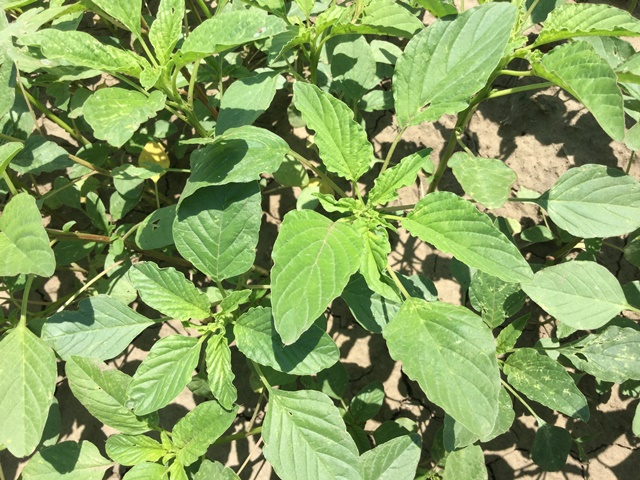Palmer amaranth
 Up to 80 to 90 percent off! In retail, this is called a loss-leader, but when those figures apply to crop yields, it’s called a nightmare. The presence of pigweeds is definitely not breaking news in southeast Kansas. However, a different pigweed species has been found which is extremely worrisome.
Up to 80 to 90 percent off! In retail, this is called a loss-leader, but when those figures apply to crop yields, it’s called a nightmare. The presence of pigweeds is definitely not breaking news in southeast Kansas. However, a different pigweed species has been found which is extremely worrisome.
Palmer amaranth (Amaranthus palmeri) has been confirmed in southeast Kansas and it is a completely unwelcome guest. Waterhemp is still the dominant pigweed species in our area. However, most of the state is more concerned with Palmer amaranth. This apprehension is based on some of Palmer’s inherent characteristics.
Palmer amaranth is actually native to the southwestern United States and was not a major pest in the Midwest until it invaded the southern plains in the late 1990’s. It is now found throughout the southeastern U.S. as well as the Corn Belt with some states (Iowa, Minnesota, and Ohio) listing it as a noxious weed.
The easiest way to differentiate between Palmer and waterhemp is probably the seed head, though we wish we could identify it before it reaches that stage. A Palmer seed head is much longer and huskier than waterhemp. While both plants are dioecious (male and female plants), a female Palmer plant has sharp bracts around the seeds which are very apparent when scouting. However, the male plant does not have these bracts and is quite soft to the touch.
If the seed head has not emerged, the two plants can be differentiated by their leaf characteristics, in particular the length of the petiole (leaf stem). In Palmer, the petiole is as long as or longer than the blade itself. This petiole length makes Palmer look quite like a poinsettia plant when viewed from above. However, in waterhemp, the blade is longer than the petiole.
Researchers at Kansas State have been studying Palmer amaranth in Kansas since the mid 90’s. The 80 and 90 percent yield loss mentioned before was from Weed Science Journal articles published in 2001 (Massinga, Currie, Horak, and Boyer) and 2003 (Bensch, Horak, and Peterson). Massinga et. al. measured over 90 percent yield loss in corn in southwest Kansas while Bensch et. al. measured nearly 80 percent yield loss in soybeans in northeast Kansas. Both of these levels were at extremely heavy populations of the weed, but it does demonstrate why producers must be wary of the pest.
In addition to high populations, both studies demonstrated that the timing of emergence played an important role in the competitiveness of the weed. The extremely high yield impacts were shown when the weed seedlings had emerged prior to the crop’s emergence.
Why is Palmer so competitive? There are a few reasons which include how fast it grows, which is must faster than waterhemp. In addition, it tends to thrive under high temperatures due to its native territory. This gives it a competitive advantage during our hot, dry summers which contributes to its yield effect.
It is also a prolific seed producer with a single plant under ideal conditions producing up to 500,000 seeds (with some sources saying even higher) under ideal conditions. However, under field conditions, seed production is much lower, though seed production is still a major concern.
In addition to its natural characteristics, Palmer has developed herbicide resistance in recent years which has made it tremendously difficult to control in some cases. In the U.S., populations of Palmer have developed resistance to group 2 (ALS), 3 (microtubule inhibitor), 4 (synthetic auxins), 5 (triazines), 9 (glyphosate), 14 (PPO), or 27 (HPPD) modes of action as well as populations resistant to multiple modes of action. Due to this, a robust integrated pest management system using a mixture of multiple effective modes of action is an absolute must in Palmer management.
While it seems hard to believe that pigweeds could be even more of a problem in southeast Kansas, the arrival of Palmer amaranth may signal just that. If you have questions or would like more information, please call me at the office (620) 724-8233, or e-mail me at jcoltrain@ksu.edu, or visit the Wildcat Extension District website at www.wildcatdistrict.ksu.edu.
Contact:
Josh Coltrain
Crop Production and Local Foods Agent
Wildcat Extension District
jcoltrain@ksu.edu
(620) 724-8233
K-State Research and Extension is an Equal Opportunity Provider and Employer
